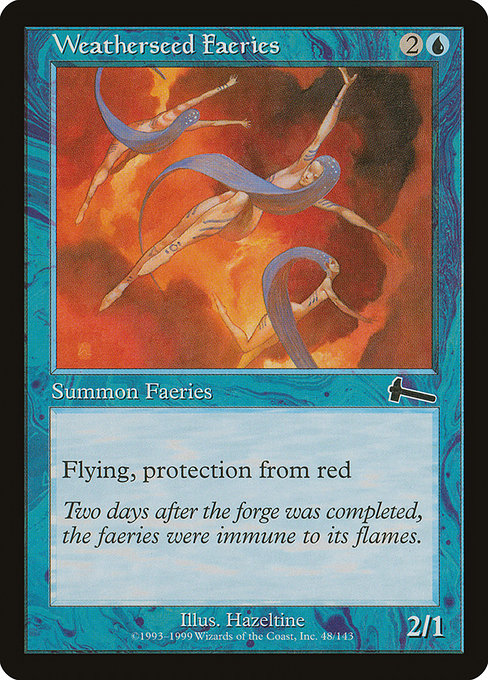
Image courtesy of Scryfall.com
Weatherseed Faeries and the Allure of Alternate Frame Art
For Blue players who love tempo, trickery, and a little faerie mischief, Weatherseed Faeries sits as a tiny jewel from the late 1990s. This little Creature — Faerie with the mana cost of {2}{U} delivers a neat package: Flying and Protection from red, a combination that can snowball protection for your win conditions while keeping advancing threats on tap. With a 2/1 body, it’s not a dragon, but in the right tempo shell it can outperform bigger, hungrier critters simply by staying power in the skies. The card’s original print appears in Urza’s Legacy (ULG) and carries the classic 1997 frame, a design that many collectors associate with the “golden age” of old-school MTG aesthetics 🧙🔥💎.
What “alternate frame art variants” really means in MTG
Alternates aren’t just about a different color border or a new font. They’re about how a card’s artwork, border, or frame has been reimagined across printings. In MTG history, you’ll encounter:
- Alternate art promos—where a card ships with a distinctly different illustration by another artist.
- Borderless and extended art variants—where the artwork fills more of the card surface, altering the framing experience.
- New frame eras—when Wizards updates the card frame, typography, or layout across reprints (for example, the shift from the classic 1997 frame to the later “new frame” that began in the early 2000s).
- Foil and etched finishes—finishes that aren’t about the frame’s look so much as the surface treatment, yet still affect how the art reads to the eye.
Weatherseed Faeries provides a clean lens for this discussion because its original print is firmly rooted in the 1997 frame style, and Scryfall’s catalog shows the card in a classic nonfoil/foil presentation with unchanged artwork within that frame. It serves as a reminder that not every card has a widely documented “alternate frame” variant, but the concept remains a living thread in the MTG collecting tapestry 🧙♂️🎨.
Weatherseed Faeries in the Urza’s Legacy era
Printed in 1999 as part of Urza’s Legacy, Weatherseed Faeries bears the flavor text, “Two days after the forge was completed, the faeries were immune to its flames.” That line hints at the era’s artifact-driven lore and the playful, perilous nature of faeries within the Urza-War era’s shifting power dynamics. The card’s artist is Don Hazeltine, whose work contributed to the era’s distinctive look. In gameplay terms, Weatherseed Faeries’ blue identity (color identity: U) lines up with classic tempo strategies: use flying threats to apply pressure while exploiting protection from red to navigate around red aggression. Its {2}{U} cost remains accessible, and the 2/1 body offers a reasonable early game clock when supported by countermagic or pump effects 🧙♀️⚔️.
The old frame’s silhouette frames a different era of magic—the font, the border, and the tiny statutory symbols all whisper a time when a card like Weatherseed Faeries could be a frontline tempo piece in a player’s strategy.
In terms of collectibility and market presence, Weatherseed Faeries remains a common print with both foil and nonfoil finishes. As of the data snapshot, you’ll see nonfoil around the $0.20 mark and foil around $1.89, reflecting a typical gap for common cards that still attract foil collectors thanks to the old-school charm. And yes, the card is Legacy-legal (and Pauper-friendly), which means it still shows up in discussions about budget-friendly blue decks that lean on evasion and protection as their core strategy 🧩💎.
How to think about alternate frames when you’re chasing variants
When evaluating Weatherseed Faeries or any card with potential frame variants, consider these guiding questions:
- Is there an official alternate art or borderless version for this card, or is the artwork the same across prints?
- Do finishes like foil or etched foil alter the perceived weight of the art or the color balance in a meaningful way?
- How does the frame era affect resale value or grading? Cards from the 1997 frame often evoke nostalgia, which can add intangible value even if monetary values are modest.
- What role does the card play in formats you care about? Weatherseed Faeries’ blue identity and protection from red can fit well in legacy tempo shells, which makes its original frame a talking point during collector conversations about era authenticity and print quality 🧭.
For those who want to deepen their exploration, Scryfall’s card pages offer a reliable map of variants and prints. You can see the card’s oracle text, its exact mana cost, power/toughness, and the artwork’s provenance. The real joy, though, is the conversation with fellow players about why certain frames feel right for a card’s temperament—the airy, delicate vibe of a Faerie versus the coarser heft of a modern frame. It’s a delightful reminder that magic isn’t just about spells and numbers; it’s about a shared sense of history and craft 🧙♂️🎲.
Where to look and how to buy (without breaking the bank)
If Weatherseed Faeries has sparked your curiosity about alternate frames, your best starting point is to compare prints on reputable price and card databases, then cross-check with recent market data. The card’s current market snapshot shows it as affordable in nonfoil form, with foils offering a bit more collectability, especially for players who want a surface that catches the light in a nostalgic way. And while you’re exploring, you might stumble upon cross-promotional goodies that fit your desk as nicely as a well-timed draw from the library. After all, MTG collecting is as much about the stories you tell as the cards you own 🎨.
As a nod to cross-promo vibes, you can pair your scouting sessions with a practical desk companion—take a look at this neon UV phone sanitizer 2-in-1 wireless charger that keeps your tech as fresh as your deck. It’s a different kind of artifact, but the thrill of discovery is equally satisfying.